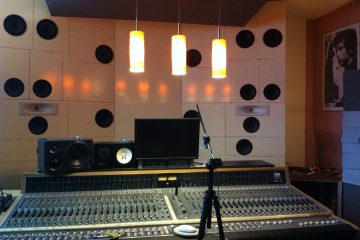An unconventional loudspeaker solution for LEWITT Audio
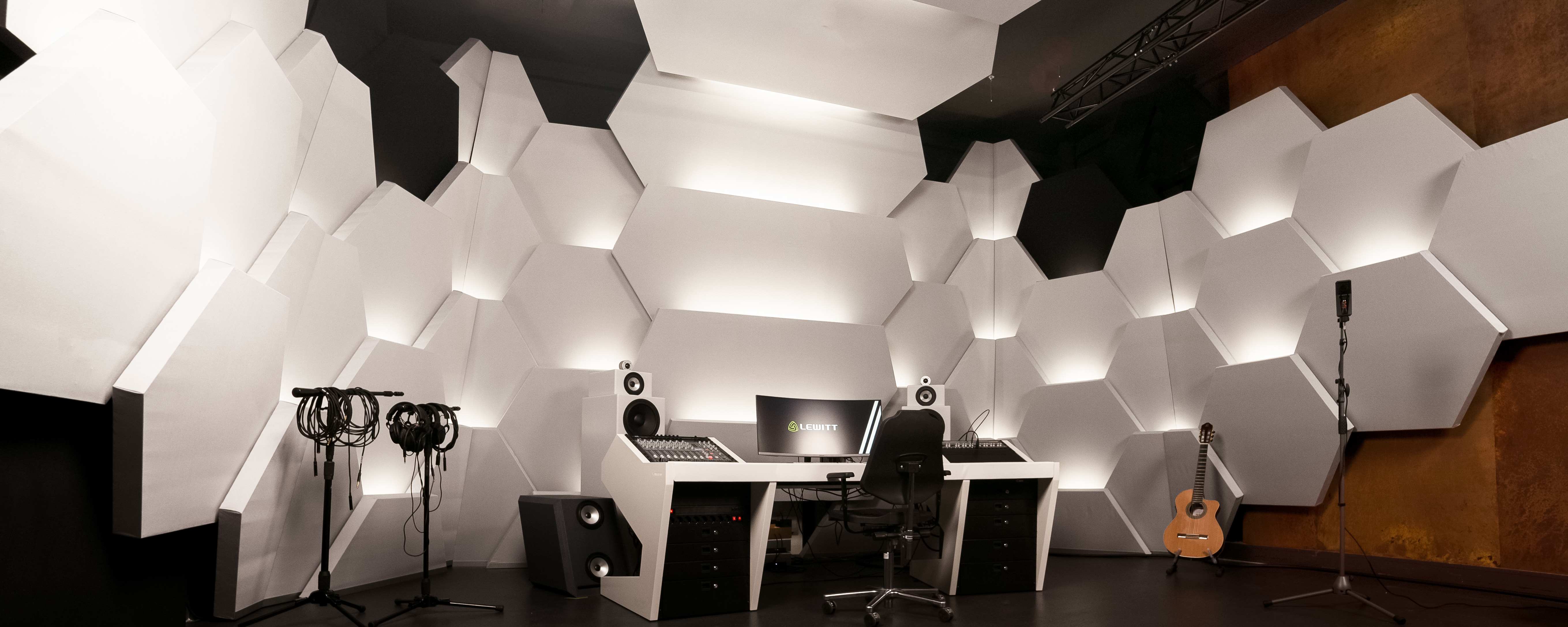
Few loudspeakers achieve linear response and perfect step response with short signal path. Now include perfect phase at crossover and do it purely analog. Finally, add a few extras, again with very few additional analog parts, to adapt this system to the LF (low frequency) room characteristic to build an exceptionally transparent loudspeaker system. Let me describe an example done recently.
Last year, LEWITT audio approached me with the question about a monitor speaker similar to the Topo, but with more low end capacity. They had tested several loudspeakers in their room, and finally wanted to combine the clear, resolving and neutral sound of the Topo with the low end of a large loudspeaker system.
After a short visit no more persuasion was necessary: that room is amazing. Looks great, and uses a nice combination of absorption and diffusion just as I like it (see my TestHiFi Blog about Lemon Audio). Different from many others, the LF absorption controls the low end perfectly. Sounds like an open space without walls.
Hence, it absorbs a lot more LF energy than most control rooms! Therefore the question for more low end …
Starting point
If you look at my regular direct radiating loudspeakers on haigner.com, you will only find relatively small speaker systems: Topo and Topolino. I consider these to be the reference for near-to-midfield listening.
They fulfill todays criteria for highest quality reproduction, such as:
- linear on-axis and even power response (not new, but still criterium number 1)
- low distortion magnet systems plus long excursion voicecoil
- low loss components: many loudspeakers rely on high damping to avoid resonances. But most damping operates non-linear, compressing dynamics and suppressing small dynamic signal shifts. It is much harder to achieve good resonance control without heavy damping. Both with cone and cabinet
- stiff cone material to shift breakup out of the passband. This is even harder to achieve with low damping
They also integrate some older ideas about good sound, eg. low moving mass – this is VERY hard to achieve in combination with above criteria.
Add to this a Haigner special, perfect time response, using only passive components (no digital controller anywhere). This needs very wide band drivers to control phase outward the passband. Extremely hard to achieve in combination with all criteria above.
To arrive at a state-of-the art product like Topo and Topolino. Small, but … not bad.
Why no larger regular systems based on these?
Bass response is very room – dependent. Therefore I offer to custom manufacture such systems for specific rooms.
And here we go.
Since the speakers will sit behind a large desk, they would either be mounted on stands, or use that space for a really large cabinet. Such a cabinet could achieve response down below 25 Hz – the choice was obvious!
Challenge no 1
Large column type cabinets, especially with the driver mounted at one end, produce strong vertical resonances. I built a test cabinet to optimize LF tuning and resonance damping. To allow for easy adjustments, the sidewall with the port is hold only by clamps.
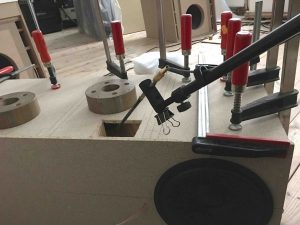
LF test cabinet for lewitt
See the strong resonance around 150 Hz measured in the nearfield of the ScanSpeak 10 inch woofer chosen.
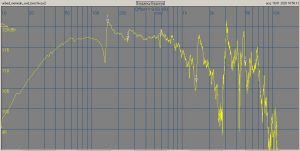
ScanSpeak nearfield wo damping
And the output of the reflex port, already tuned to the final 21 Hz. Yellow = with the first reactive absorber, red = without any internal absorption. To avoid abundant absorptive fill, I use combinations of Helmholtz- with quarter-wavelength absorption. Regular absorptive treatment would just damp the whole port output, but is less effective to eliminate resonances.
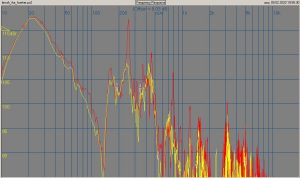
port nearfield incl 1 IHA
Add some strategically placed absorptive fill, and that’s it. Nearfield sum of port and diaphragm, corrected for different arrival time (sideways port) and scaled for 1 m distance in free air.
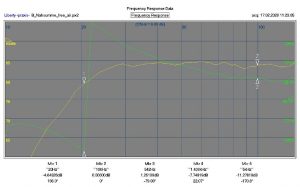
LF nearfield sum free air
The impedance plot shows the low loss of the low frequency (LF) system (add more damping and the 2 LF peaks will strongly diminish)
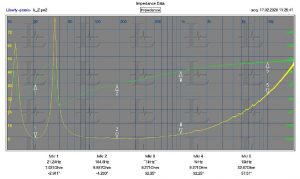
LF impedance
Challenge no 2
Only few woofers offer low distortion above 500 Hz and provide response below 30 Hz. The ScanSpeak unit chosen is good at both frequency ends. Why the need for that?
This LF unit is combined with a Topolino-style mid-high (MF-HF) frequency unit. Separate amplifiers drive LF and MF/HF. I choose a Shiit Aegir for MF/HF and Vidar class a/b for LF. Their different gain compensates sensitivity differences.
To keep the perfect step response of the MF-HF system, there is basically no LF filter: the natural rolloff of the ScanSpeak driver is corrected by a simple passive network to adjust the response similar to the MF driver’s. Add a notch filter to control the aluminum cone breakup resonance.
A gentle shelve attenuates LF 15 dB at 1 kHz compared to MF. Build with only 3 passive components in front of the LF amplifier. All filter influence is simulation-optimized to achieve perfect relative phase between LF and MF drivers. Until the LF time / phase lag compared to the MF/HF system can be eliminated with a simple backward shift of MF/LF.
See the step response at the listening position of MF/HF (yellow) and LF (red).
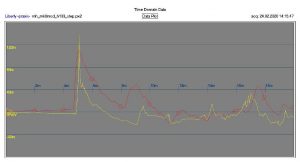
MH and LF step response
(floor reflection at about 8 and 9 ms from LF and MF/HF system).
Finally, here it is: quite tall! They are sitting high at LEWITT Audio, behind a huge desk.
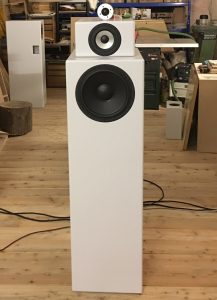
lewitt system
Including all room influence (strong attenuation of everything below 35 Hz due to mid-room position) , here a screenshot of the combined response. Please mind the high resolution, only 2 dB per diversity!
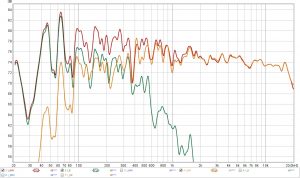
LF – MH – sum
Challenge no 3
Delivered and setup at LEWITT, sound was … ok. Nice top end, but where is that glorious low end I’d heard at my workshop? Turns out there is some boundary cancellation in the bass region on both channels. Something they seemed to have experienced with other speakers before … left and right channel response (top) compared to that at the workshop (below).
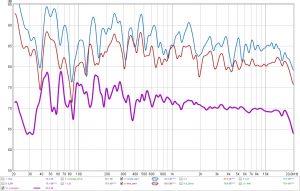
lewitt – workshop comparison
Besides some desktop interference from midrange to presence region, there is a wide dip from 60 – 120 Hz in both channels response!
I adjusted LF gain and shelve as good as possible, with only small improvements. Also, shifting speaker positions within the restrictions for an acceptable listening triangle, did not help much. Front- and sidewall reflections kept killing most energy around 80-90 Hz.
To absorb such low frequencies, would need a lot of absorption added. Some days later I had a different, if quite unconventional idea:
How about using a filler driver?
Positioned outside the main speakers, to achieve better coupling to the room acoustics? Did a few room simulations and tried to simulate the driver needed. And found a pair of test cabinets that perfectly fitted the bill. Two 6.5 inch long excursion units per side, housed in cabinets with slanted baffles to aim midrange towards the ear. They had to fulfill the same midrange quality requirements as the main woofer. With the 2 drivers series connected and a passive filter to achieve the desired response, simulation looked perfect. Step response undisturbed! And the additional 16 ohms load is no problem for the Shiit Vidar. Best of all: sensitivity fits perfect for the job – just parallel connect them to the main woofer …
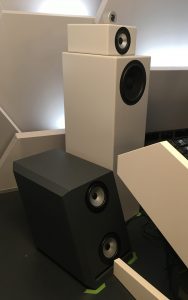
LF filler
Nearfield measurements of contributions from LF, filler and MF system. Scaled according to relative listening distances, but LF port not included.
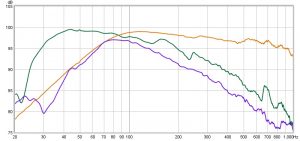
LF – filler – MF relskal
Fills the gap perfectly in phase with the main woofer.
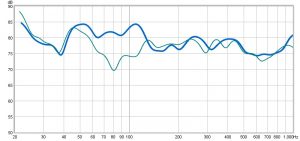
filler effect
(some speaker shifting between measurements …)
I returned for a third and final fine-tuning session. Due to complex acoustical paths the filler’s response sloped down too early in the upper bass, and the previous wide dip region was now too loud. A shelve for the midrange to attenuate it’s LF end helps to reduce this and MF excursion. Good for SPLmax. Changing the passive filler filter towards more midrange helped to smooth it all nicely. Happy faces around!
The result
shows the advantage of this remarkable space: walking back along the symmetry axis towards the rear wall without any change of LF characteristics. Nice and even everywhere!
Those who own and care about a high end sound system know it is often a step-by-step approach to achieve excellent sound in a given room.
LF reproduction can be tricky, even in an amazing room like this. One more reason for custom design 🙂
